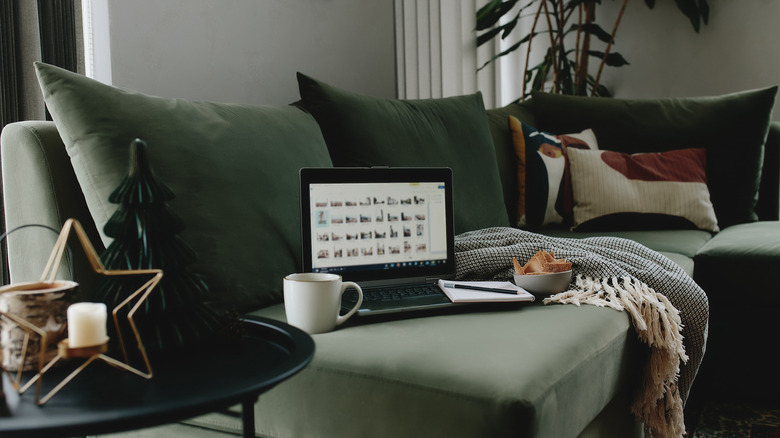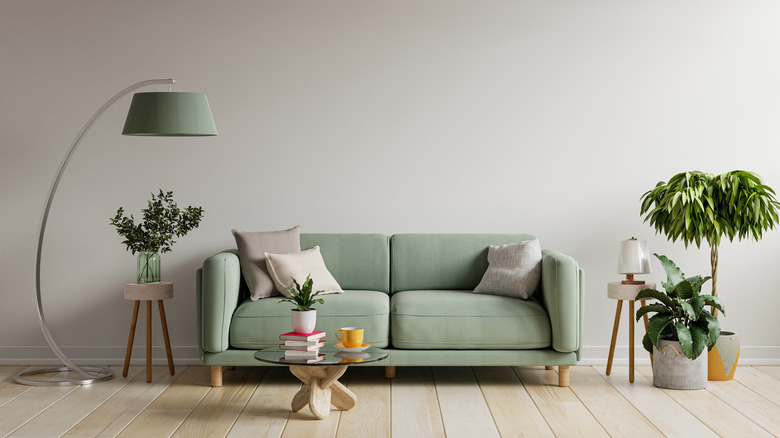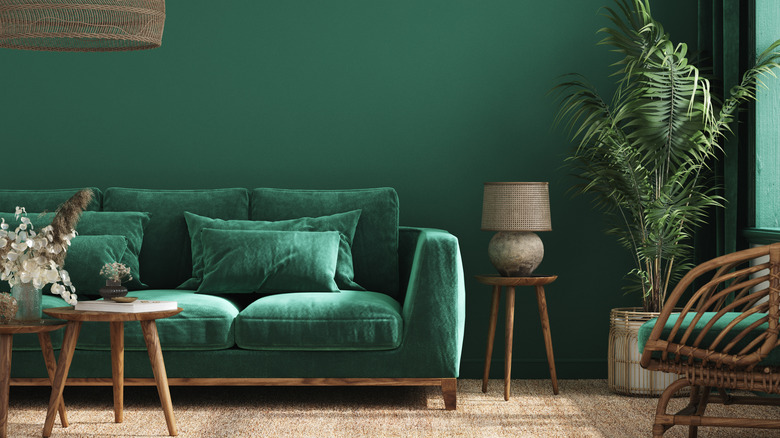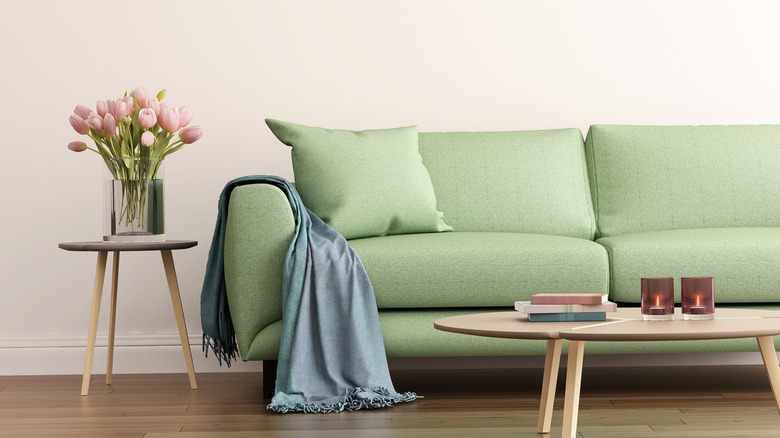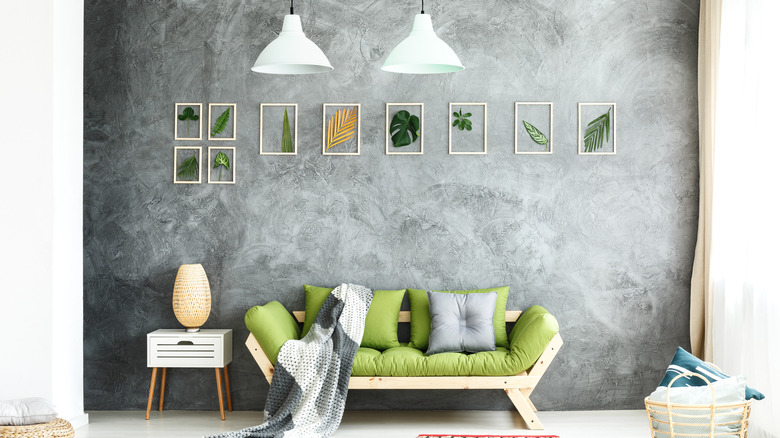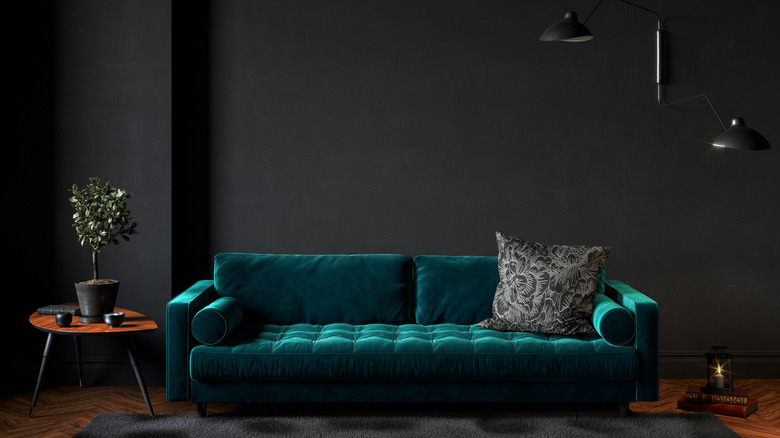5 Paint Colors That Go Well With A Green Couch
Your furniture not only provides comfort to your home but embodies style and inspiration as well. Whether you've opted for subtle, muted colors or bright and bold materials, each piece represents your unique personality. Choosing a couch to become a focal point in your living or sitting room is a big decision, one that will affect how the rest of the space pulls together. This important piece of furniture not only creates a cozy respite to enjoy movies or time with your loved ones, but it also becomes the backdrop and muse for the paint and accents that cover the walls and surfaces. According to Smooth Decorator, people who pick green for their homes also enjoy listening and engaging with others, as well as making them feel heard and soothed.
If you've chosen a green couch, you might be wondering what shades to paint the walls that surround it. While a number of options pair well with this color, certain selections might go better than others and help the sofa stand out. Even if you prefer to have it blend in with the surroundings more, some tones and palettes will suit that purpose better than others. The following suggestions are a great jumping-off point for decorating the area your couch occupies and gives you a better idea of what to look for when paint shopping.
1. Tan
Tan might seem like an unusual choice to pair with your green sofa, but it actually complements a variety of colors quite well. Because of its earthy undertones, tan paint is a good option for a number of materials and statement pieces, because it complements them without taking anything away. Instead of drawing the eye from the focal point, aka your green couch, it softly contrasts it, creating an easy backdrop on which to build. According to Farm Food Family, this versatile hue can create a sense of safety and security in a room, channeling the earthy vibes that make people feel welcome.
Browns and tans match so well with green because they're both associated with the earth, too. Think of the outdoors, and how often these two colors coexist. By bringing them into your interior aesthetic, you're creating a grounded space that allows people to feel at one with their surroundings and nature. Just like a relaxing wander outside, engaging with this interior design choice will inspire a sense of calm and belonging within and without.
2. Green
It's no surprise that green can complement other shades of the same color. Just look at the forests, where a multitude of tones and hues coexist and create the greatest backdrops you can find. With that in mind, seeking out other options on this palette can help turn your living space into a dreamy, nature-inspired getaway or a bright and bold respite. According to Houzz, using different greens in a room can create a dramatic effect, so layering it can produce something truly dazzling and unique.
One of the most important things to consider before pairing green with green is the undertones. Depending on the shade of your couch, you want to choose a paint option that complements it properly. If there are blue undertones, find hues that make those pop and combine well with them. If you're leaning toward a purple shade, seek out hues that will blend with the cool side of the color. If the couch is dark, experiment with lighter greens and accent walls, but if the sofa is on the lighter side, use deeper tones to create depth and dimension.
3. Beige
Another well-loved neutral and easy option for a variety of colors is beige. This incredibly neutral shade matches almost everything and creates a simple backdrop that's easy to build on, depending on your theme. Mixing this paint possibility with a green couch can make the latter pop, drawing attention to the statement piece without making too big a contrast. Beige adds warmth to any space, making it feel inviting and cozy.
Another earthy combination, it can work with light or dark shades of green without feeling too oppressive or subdued. It sits evenly in the middle of subtle and strong, so you can pull it through with decor and accents, too. Living Spaces recommends also using beige in an office or workspace as it increases productivity, so if your couch sits in a shared space or an area that connects with a location where you do work, pull this paint color through for added calm and focus.
4. Gray
You have the option to veer toward neutral or bright palettes with a green couch, but it can be easier to work with neutral shades. Gray is amazing to blend with bold or subdued fabrics, as it offers a relaxed color that isn't too light but doesn't appear too dark either. According to Karen Haller in an article by The Design Sheppard, if you're looking to "tone down" a particular piece, gray can be used to help with this.
Maybe your statement item feels too focal, in which case using a more relaxed and "security-based" color will cloak it slightly, bringing everything to an approachable level without completely dulling the material or fabric's shine. Knowing how to use different colors and shades to contrast is just as important as using them to complement. Louder pieces can easily fit into a neutral room with the right paint, and for your brighter sofa, a soft gray will create the ideal juxtaposition.
5. Black
Are you feeling a little brave with your interior design? If something jaw-dropping but enviable is on your list of home "to-do's," using black paint against your green couch is the answer. Black can be an intimidating shade to choose when it comes to your walls, but it is actually one of the most decadent options you can go with. According to Decor Tips, not only is this color perfect for accenting certain accessories throughout the room, but it also makes spaces look bigger. This is due to the fact that the corners aren't as noticeable with the dark shade, almost becoming non-existent. This effect opens up the area exponentially.
Using black and greens also allows for fun decor opportunities, mixing in other pops of color or neutrals to contrast with the two bold selections. Use bits of gray, beige, or cream in the form of throw pillows and blankets, or patterned black fabrics that pull the theme through. Make the couch your focal point, using the brighter tone to create a unique and engaging atmosphere that will leave guests wanting to try the same design techniques in their homes.
